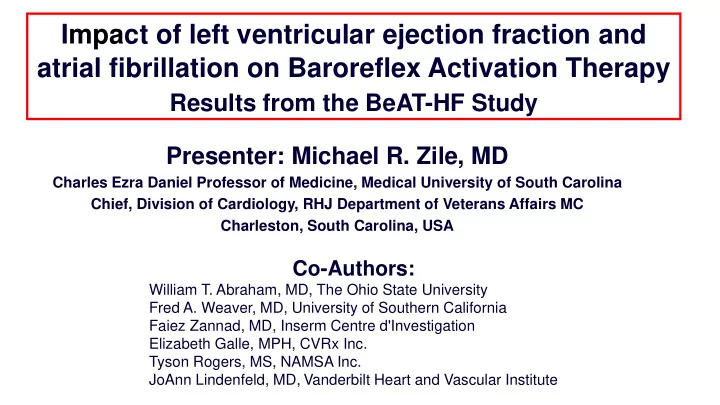

Impact of left ventricular ejection fraction and atrial fibrillation on Baroreflex Activation Therapy Results from the BeAT-HF Study Presenter: Michael R. Zile, MD Charles Ezra Daniel Professor of Medicine, Medical University of South Carolina Chief, Division of Cardiology, RHJ Department of Veterans Affairs MC Charleston, South Carolina, USA Co-Authors: William T. Abraham, MD, The Ohio State University Fred A. Weaver, MD, University of Southern California Faiez Zannad, MD, Inserm Centre d'Investigation Elizabeth Galle, MPH, CVRx Inc. Tyson Rogers, MS, NAMSA Inc. JoAnn Lindenfeld, MD, Vanderbilt Heart and Vascular Institute
Presenter Disclosure Information I will discuss research examining the development of new therapies in my presentation. I have financial relationships to disclose: Employee of: Department of Veterans Affairs, Medical University of SC Consultant for: Abbott, Boston Scientific, Corvia, CVRx, Cyclerion, EBR, Endotronics, Eli Lilly, Janssen, Medtronic, Merck, Myokardia, Novartis, ReCor, V Wave Stockholder in: N/A Research support from: NHLBI, VA, DOD, CVRx, Medtronic, Novartis
BeAT-HF Top-Line Results Exercise NT-proBNP Quality of Life Capacity (change from Baseline) (% change from Baseline) (change from Baseline) p<0.001 6 Month MLWHF 6 Month NT-proBNP 6 Month 6MHW Improvement Improvement Improvement p<0.001 p=0.004 BAT Control Diff BAT Control Diff BAT Control Diff Zile et al, JACC 2020, in press
Atrial Fibrillation Distribution Variable N (%) No AF 169 (64%) Paroxysmal 63 (24%) Permanent 8 (3%) Persistent 22 (8%) Unknown 2 (1%) Ejection Fraction Distribution Variable N (%) EF 35-25% 201 (76%) EF < 25% 63 (24%)
Outcomes by Baseline AF Status 100 100% AF No AF AF No AF Change from Baseline to 6M Six Minute Hall Walk (meters) 80 NYHA Class (% improved) Change from Baseline to 6M 67* 80% 67% 57* 60 61% 50 48 60% 40 37%* 40% 33% 30% 20 28%* 20% 0 -8 -8 0% -20 BAT Control Diff BAT Control Diff BAT Control Diff BAT Control Diff 20% 0 Change from Baseline to 6M 10% 7% MLWHF Quality of Life (Points) NT-proBNP (% Reduction) Change from Baseline to 6M -5 -5 0% -8 -10 -1.0% -10% -12* -15 -20% -16* -20% -23% -20 -24% -25%* -30% -20 -21 * p<0.05 -25 -40% There were no significant interaction P-values for AF vs no AF for any parameter measured, all > 0.05
Outcomes by Baseline EF Status 100 LVEF 35 – 25% LVEF < 25% LVEF 35 – 25% LVEF < 25% 100% NYHA Class (% improved) Change from Baseline to 80 76* Six Minute Hall Walk (meters) Change from Baseline to 6M 80% 67% 56* 64% 60 52 48 60% 6M 40 36% 40% 34%* 31%* 30% 20 20% 0 -5 -20 0% -18 BAT Control Diff BAT Control Diff 30% BAT Control Diff BAT Control Diff -40 18% 0 20% Change from Baseline to 6M NT-proBNP (% Reduction) 10% MLWHF Quality of Life (Points) Change from Baseline to 6M -5 -5 0% -7 -0.5% -10 -10% -20% -13* -15 -20% -20% -15* -30% -25% -17 -20 -40% -38% -22 * p<0.05 -50% -25 There were no significant interaction P-values for EF 35-25% vs <25% for any parameter measured, all > 0.05
Outcomes by Baseline EF and AF Status 6M Improvement BAT vs Control History of AF No History of AF BAT N=28 BAT N=62 LVEF 25 – 35% Control N=46 Control N=51 6MHW (meters) 59* 51* MLWHF (points) -12* -15* NYHA(% improved) 30%* 37%* NT-proBNP (% Reduction) -11% -24% BAT N=5 BAT N=25 LVEF < 25% Control N=8 Control N=20 6MHW (meters) 127* 76* MLWHF (points) -16* -15* NYHA(% improved) 10% 38%* NT-proBNP (% Reduction) -64%* -27% * p<0.05
Conclusions ➢ BAT significantly improved patient-centered symptomatic endpoints • quality of life score • exercise capacity, and • functional status. ➢ These results were supported by objective evidence of significant reduction of NT-proBNP. ➢ BAT is equally safe and effective in patients with or without Atrial Fibrillation. ➢ BAT is equally safe and effective in patients with ejection fraction 35-25% or < 25%.
Recommend
More recommend